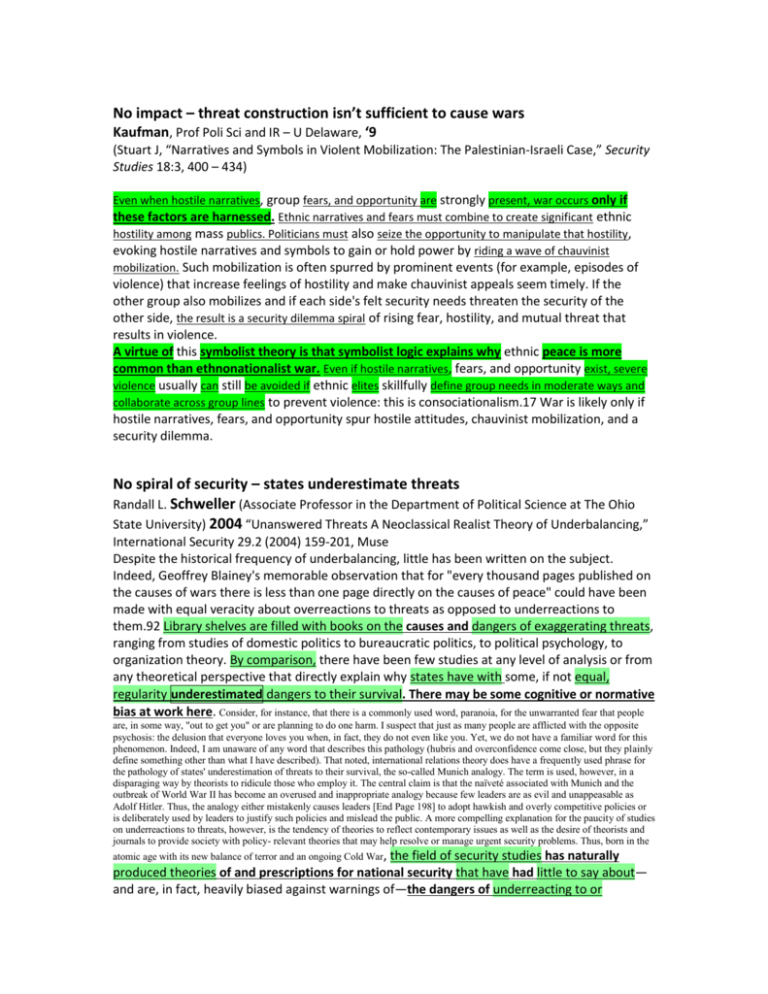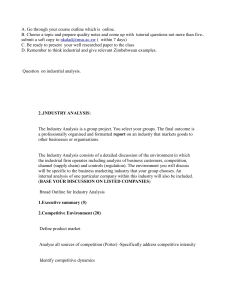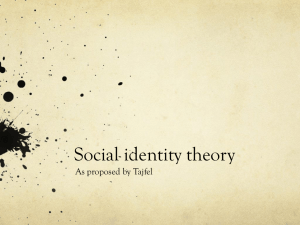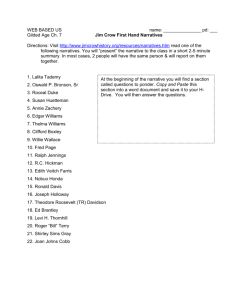Missouri State-Bess-Rumbaugh-1ar-UMKC
advertisement

No impact – threat construction isn’t sufficient to cause wars Kaufman, Prof Poli Sci and IR – U Delaware, ‘9 (Stuart J, “Narratives and Symbols in Violent Mobilization: The Palestinian-Israeli Case,” Security Studies 18:3, 400 – 434) Even when hostile narratives, group fears, and opportunity are strongly present, war occurs only if these factors are harnessed. Ethnic narratives and fears must combine to create significant ethnic hostility among mass publics. Politicians must also seize the opportunity to manipulate that hostility, evoking hostile narratives and symbols to gain or hold power by riding a wave of chauvinist mobilization. Such mobilization is often spurred by prominent events (for example, episodes of violence) that increase feelings of hostility and make chauvinist appeals seem timely. If the other group also mobilizes and if each side's felt security needs threaten the security of the other side, the result is a security dilemma spiral of rising fear, hostility, and mutual threat that results in violence. A virtue of this symbolist theory is that symbolist logic explains why ethnic peace is more common than ethnonationalist war. Even if hostile narratives, fears, and opportunity exist, severe violence usually can still be avoided if ethnic elites skillfully define group needs in moderate ways and collaborate across group lines to prevent violence: this is consociationalism.17 War is likely only if hostile narratives, fears, and opportunity spur hostile attitudes, chauvinist mobilization, and a security dilemma. No spiral of security – states underestimate threats Randall L. Schweller (Associate Professor in the Department of Political Science at The Ohio State University) 2004 “Unanswered Threats A Neoclassical Realist Theory of Underbalancing,” International Security 29.2 (2004) 159-201, Muse Despite the historical frequency of underbalancing, little has been written on the subject. Indeed, Geoffrey Blainey's memorable observation that for "every thousand pages published on the causes of wars there is less than one page directly on the causes of peace" could have been made with equal veracity about overreactions to threats as opposed to underreactions to them.92 Library shelves are filled with books on the causes and dangers of exaggerating threats, ranging from studies of domestic politics to bureaucratic politics, to political psychology, to organization theory. By comparison, there have been few studies at any level of analysis or from any theoretical perspective that directly explain why states have with some, if not equal, regularity underestimated dangers to their survival. There may be some cognitive or normative bias at work here. Consider, for instance, that there is a commonly used word, paranoia, for the unwarranted fear that people are, in some way, "out to get you" or are planning to do one harm. I suspect that just as many people are afflicted with the opposite psychosis: the delusion that everyone loves you when, in fact, they do not even like you. Yet, we do not have a familiar word for this phenomenon. Indeed, I am unaware of any word that describes this pathology (hubris and overconfidence come close, but they plainly define something other than what I have described). That noted, international relations theory does have a frequently used phrase for the pathology of states' underestimation of threats to their survival, the so-called Munich analogy. The term is used, however, in a disparaging way by theorists to ridicule those who employ it. The central claim is that the naïveté associated with Munich and the outbreak of World War II has become an overused and inappropriate analogy because few leaders are as evil and unappeasable as Adolf Hitler. Thus, the analogy either mistakenly causes leaders [End Page 198] to adopt hawkish and overly competitive policies or is deliberately used by leaders to justify such policies and mislead the public. A more compelling explanation for the paucity of studies on underreactions to threats, however, is the tendency of theories to reflect contemporary issues as well as the desire of theorists and journals to provide society with policy- relevant theories that may help resolve or manage urgent security problems. Thus, born in the atomic age with its new balance of terror and an ongoing Cold War, the field of security studies has naturally produced theories of and prescriptions for national security that have had little to say about— and are, in fact, heavily biased against warnings of—the dangers of underreacting to or underestimating threats. After all, the nuclear revolution was not about overkill but, as Thomas Schelling pointed out, speed of kill and mutual kill.93 Given the apocalyptic consequences of miscalculation, accidents, or inadvertent nuclear war, small wonder that theorists were more concerned about overreacting to threats than underresponding to them. At a time when all of humankind could be wiped out in less than twenty-five minutes, theorists may be excused for stressing the benefits of caution under conditions of uncertainty and erring on the side of inferring from ambiguous actions overly benign assessments of the opponent's intentions. The overwhelming fear was that a crisis "might unleash forces of an essentially military nature that overwhelm the political process and bring on a war thatnobody wants. Many important conclusions about the risk of nuclear war, and thus about the political meaning of nuclear forces, rest on this fundamental idea."94 Now that the Cold War is over, we can begin to redress these biases in the literature. In that spirit, I have offered a domestic politics model to explain why threatened states often fail to adjust in a prudent and coherent way to dangerous changes in their strategic environment. The model fits nicely with recent realist studies on imperial under- and overstretch. Specifically, it is consistent with Fareed Zakaria's analysis of U.S. foreign policy from 1865 to 1889, when, he claims, the United States had the national power and opportunity to expand but failed to do so because it lacked sufficient state power (i.e., the state was weak relative to society).95 Zakaria claims that the United States did [End Page 199] not take advantage of opportunities in its environment to expand because it lacked the institutional state strength to harness resources from society that were needed to do so. I am making a similar argument with respect to balancing rather than expansion: incoherent, fragmented states are unwilling and unable to balance against potentially dangerous threats because elites view the domestic risks as too high, and they are unable to mobilize the required resources from a divided society. The arguments presented here also suggest that elite fragmentation and disagreement within a competitive political process, which Jack Snyder cites as an explanation for overexpansionist policies, are more likely to produce underbalancing than overbalancing behavior among threatened incoherent states.96 This is because a balancing strategy carries certain political costs and risks with few, if any, compensating short-term political gains, and because the strategic environment is always logrolling among fragmented elites within threatened states is more likely to generate overly cautious responses to threats than overreactions to them. This dynamic captures the underreaction of democratic states to the rise of Nazi Germany during the interwar period.97 In addition to elite fragmentation, I have suggested some basic domestic-level variables that regularly intervene to thwart balance of power predictions. somewhat uncertain. Consequently, Violence is decreasing due to US hegemony- it’s a DA to the alt as well Daniel W. Drezner Associate Professor of International Politics at the Fletcher School of Law and Diplomacy at Tufts University May 25, 2005 “Gregg Easterbrook, war, and the dangers of extrapolation” http://www.danieldrezner.com/archives/002087.html The University of Maryland studies find the number of wars and armed conflicts worldwide peaked in 1991 at 51, which may represent the most wars happening simultaneously at any point in history. Since 1991, the number has fallen steadily. There were 26 armed conflicts in 2000 and 25 in 2002, even after the Al Qaeda attack on the United States and the U.S. counterattack against Afghanistan. By 2004, Marshall and Gurr's latest study shows, the number of armed conflicts in the world had declined to 20, even after the invasion of Iraq. All told, there were less than half as many wars in 2004 as there were in 1991. Marshall and Gurr also have a second ranking, gauging the magnitude of fighting. This section of the report is more subjective. Everyone agrees that the worst moment for human conflict was World War II; but how to rank, say, the current separatist fighting in Indonesia versus, say, the Algerian war of independence is more speculative. Nevertheless, the Peace and Conflict studies name 1991 as the peak post-World War II year for totality of global fighting, giving that year a ranking of 179 on a scale that rates the extent and destructiveness of combat. By 2000, in spite of war in the Balkans and genocide in Rwanda, the number had fallen to 97; by 2002 to 81; and, at the end of 2004, it stood at 65. This suggests the extent and intensity of global combat is now less than half what it was 15 years ago. Easterbrook spends the rest of the essay postulating the causes of this -- the decline in great power war, the spread of democracies, the growth of economic interdependence, and even the peacekeeping capabilities of the United Nations. Easterbrook makes a lot of good points -- most people are genuinely shocked when they are told that even in a post-9/11 climate, there has been a steady and persistent decline in wars and deaths from wars. That said, what bothers me in the piece is what Easterbrook leaves out. First, he neglects to mention the biggest reason for why war is on the decline -- there's a global hegemon called the United States right now. Easterbrook acknowledges that "the most powerful factor must be the end of the cold war" but he doesn't understand why it's the most powerful factor. Elsewhere in the piece he talks about the growing comity among the great powers, without discussing the elephant in the room: the reason the "great powers" get along is that the United States is much, much more powerful than anyone else. If you quantify power only by relative military capabilities, the U.S. is a great power, there are maybe ten or so middle powers, and then there are a lot of mosquitoes. [If the U.S. is so powerful, why can't it subdue the Iraqi insurgency?--ed. Power is a relative measure -- the U.S. might be having difficulties, but no other country in the world would have fewer problems.] Joshua Goldstein, who knows a thing or two about this phenomenon, made this clear in a Christian Science Monitor op-ed three years ago: We probably owe this lull to the end of the cold war, and to a unipolar world order with a single superpower to impose its will in places like Kuwait, Serbia, and Afghanistan. The emerging world order is not exactly benign – Sept. 11 comes to mind – and Pax Americana delivers neither justice nor harmony to the corners of the earth. But a unipolar world is inherently more peaceful than the bipolar one where two superpowers fueled rival armies around the world. The long-delayed "peace dividend" has arrived, like a tax refund check long lost in the mail. The difference in language between Goldstein and Easterbrook highlights my second problem with "The End of War?" Goldstein rightly refers to the past fifteen years as a "lull" -- a temporary reduction in war and war-related death. The flip side of U.S. hegemony being responsible for the reduction of armed conflict is what would happen if U.S. hegemony were to ever fade away. Easterbrook focuses on the trends that suggest an ever-decreasing amount of armed conflict -- and I hope he's right. But I'm enough of a realist to know that if the U.S. should find its primacy challenged by, say, a really populous non-democratic country on the other side of the Pacific Ocean, all best about the utility of economic interdependence, U.N. peacekeeping, and the spread of democracy are right out the window. Our evidence is based on the best sociological studies- and can be explained outside of the security paradigm William C. Wohlforth is a professor of government at Dartmouth College World Politics Volume 61, Number 1, January 2009 Unipolarity, Status Competition, and Great Power War Mainstream theories generally posit that states come to blows over an international status quo only when it has implications for their security or material well-being. The guiding assumption is that a state’s satisfaction [End Page 34] with its place in the existing order is a function of the material costs and benefits implied by that By that assumption, once a state’s status in an international order ceases to affect its material wellbeing, its relative standing will have no bearing on decisions for war or peace. But the assumption is undermined by cumulative research in disciplines ranging from neuroscience and evolutionary biology to economics, anthropology, sociology, and psychology that human beings are powerfully motivated by the desire for favorable social status comparisons. This research suggests that the preference for status is a basic disposition rather than merely a strategy for status.24 attaining other goals.25 People often seek tangibles not so much because of the welfare or security they bring but because of the social status they confer. Under certain conditions, the search for status will cause people to behave in ways that directly contradict their material interest in security and/or prosperity. Much of this research concerns individuals, but international politics takes place between groups. Is there reason to expect individuals who act in the name of states to be motivated by status concerns? Compelling findings in social psychology suggest a positive answer. Social identity theory (sit) has entered international relations research as a psychological explanation for competitive interstate behavior.26 According to the theory’s originator, Henri Tajfel, social identity is “that part of an individual’s self-concept which derives from his knowledge of his membership of a social group (or groups) together with the value and emotional significance attached to that membership.”27 Tajfel and his followers argue that deep- seated human motivations of self-definition and self-esteem induce people to define their identity in relation to their in-group, to compare and contrast that in-group with out-groups, and to want that comparison to reflect favorably on themselves. In a [End Page 35] remarkable set of experiments that has since been replicated dozens of times, Tajfel and his collaborators found that simply assigning subjects to trivially defined “minimal” in-groups led them to discriminate in favor of their in-group at the expense of an out-group, even when nothing else about the setting implied a competitive relationship. Although sit appears to provide a plausible candidate explanation for interstate conflict, moving beyond its robust but general implication about the ubiquitous potential for status seeking to specific hypotheses about state behavior has proved challenging. In particular, experimental findings concerning which groups individuals will select as relevant comparisons and which of many possible identity-maintenance strategies they will choose have proved highly sensitive to the assumptions made about the social context. The results of experimental research seeking to predict responses to status anxiety—whether people will choose social mobility (identifying with a higher status group), social creativity (seeking to redefine the relevant status-conferring dimensions to favor those in which one’s group excels), social conflict (contesting the statussuperior group’s claim to higher rank), or some other strategy—are similarly highly context dependent.28 For international relations the key unanswered question remains: under what circumstances might the constant underlying motivation for a positive self-image and high status translate into violent conflict? While sit research is suggestive, standard concerns about the validity of experimental findings are exacerbated by the fact that the extensive empirical sit literature is generally not framed in a way that captures salient features of international relations. The social system in which states operate is dramatically simpler than the domestic social settings much of the research seeks to capture. Decision makers’ identification with the state is generally a given, group boundaries are practically impermeable, and there are very few great powers and very limited mobility. For states, comparison choice and the selection of status- maintenance strategies are constrained by exogenous endowments and geographical location. Natural and historical endowments—size and power potential—vary much more among states than among individuals [End Page 36] and so play a much larger role in determining hierarchies and influencing the selection of identity maintenance strategies. Assumptions built into most sit research to date generally do not capture these realities of interstate life. In particular, standard sit research designs beg the question of the expected costs of competing for status. Experiments do not generally posit situations in which some groups are endowed with demonstrably superior means with which to discriminate in favor of their own group at the expense of outgroups. Indeed, built in to most experimental setups is an implied assumption of material equality among groups. Yet international politics is notable as a social realm with especially large disparities in material capabilities, and decision makers are unlikely to follow identity-maintenance strategies that are demonstrably beyond their means. Nevertheless, there is no reason to doubt the relevance for states of sit’s core finding that individual preferences for higher status will affect intergroup interactions. Individuals who identify with a group transfer the individual’s status preference to the group’s relations with other groups. If those who act on behalf of a state (or those who select them) identify with that state, then they can be expected to derive utility from its status in international society. In addition, there are no evident reasons to reject the theory’s applicability to interstate settings that mimic the standard sit experimental setup—namely, in an ambiguous hierarchy of states that are comparable in material terms. As Jacques Hymans notes: “In the design of most sit experiments there is an implicit assumption of rough status and power parity. Moreover, the logic of sit theory Status conflict is thus more likely in flat, ambiguous hierarchies than in clearly stratified ones. And there are no obvious grounds for suggests that its findings of ingroup bias may in fact be dependent on this assumption.”29 rejecting the basic finding that comparison choice will tend to be “similar but upward” (that is, people will compare and contrast their group with similar but higher status groups).30 In most settings outside the laboratory this leaves a lot of room for consequential choices, but in the context of great power relations, the set of feasible comparison choices is constrained in highly consequential ways. [End Page 37]









